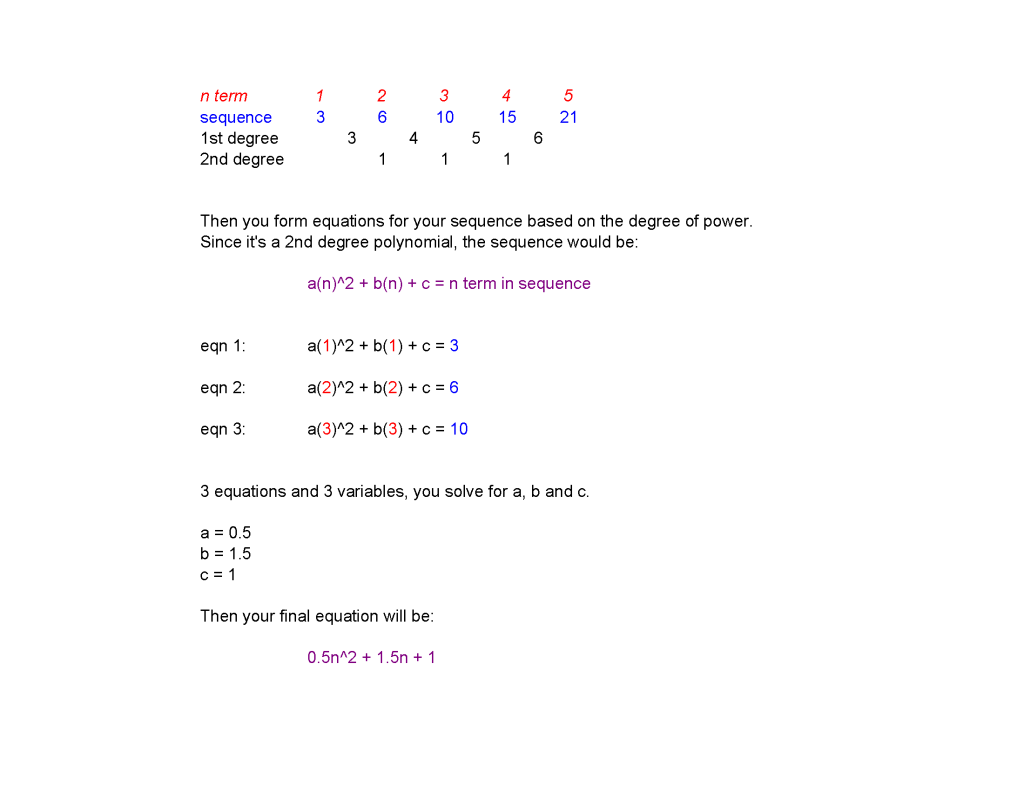Maths Question
-
 ANS for question B: 1/2 (N+1)(N+2)y is inversely proportional to x².
ANS for question B: 1/2 (N+1)(N+2)y is inversely proportional to x².
If x is increased by 300%, find the percentage decrease in y. -
y = 1 / x^2
you go do the maths.

-
It is y = k/x^2, where k is a constant lah.
-
Ok so how should I add the 300%? y = k/x^2+ 300%? Anyone have solution for question b?
-
3,6,10,15,21
Tn = 0.5n^2 + 1.5n + 1
-
get a proper teacher.
posting your vacation homework online is just weird.
-
Originally posted by skythewood:
get a proper teacher.
posting your vacation homework online is just weird.
Maybe he is taking the Os this year and preparing for his paper 2. Too late to get a tutor.
-
Originally posted by Mikethm:
Maybe he is taking the Os this year and preparing for his paper 2. Too late to get a tutor.
a good session with any tutor is much more effective than posting and waiting for answers online.
ask teachers, ask classmates or get tutor will be more effective.
-
My option are limited and I'm not a full-time student.
-
deleted
-
x = 1:
y = 1/1^2 = 1/1 = 1
increase by 300%
y = 1/4^2 = 1/16
percentage decrease:
(1/16 - 1) / 1 x 100% = -93.75%
confirm your results by trying another value of x:
x = 5
y = 1/5^2 = 1/25
increase by 300%:
y = 1/20^2 = 1/400
percentage decrease:
(1/400 - 1/25) / (1/25) x 100% = -93.75%
don't have to try fancy methods, just think logically and you will get it.

good luck.
-
Hi my answer for question B is correct.
0.5n^2-1.5n+1
= (1/2)(n^2+3n+2)
= (1/2)(n+1)(n+2)
The format is different coz the textbook got it by observation, I got it by brainless idiot proof method.
-
There is a technique for solving your sequence. First write down the sequence, then find the difference between each number in the series. After you have discovered a constant number (in your case, the constant is 1), it will determine the degree of power for your sequence.

-
Thank you all for all the help.

-
Originally posted by maurizio13:
There is a technique for solving your sequence. First write down the sequence, then find the difference between each number in the series. After you have discovered a constant number (in your case, the constant is 1), it will determine the degree of power for your sequence.

the most brainless method, as pointed out by mike, is by using (1/2)(n+1)(n+2)
if you generate from n=0, you get,
1,3,6,10,15...you see in between, +2, +3, +4, +5
from there, you can find out many things... :)
There are other equally brainless methods as well, but sad to say, my compiled list from sec sch has been lost by one of my previous students when I just started out teaching... sigh....
-
Originally posted by eagle:
the most brainless method, as pointed out by mike, is by using (1/2)(n+1)(n+2)
if you generate from n=0, you get,
1,3,6,10,15...you see in between, +2, +3, +4, +5
from there, you can find out many things... :)
There are other equally brainless methods as well, but sad to say, my compiled list from sec sch has been lost by one of my previous students when I just started out teaching... sigh....
Actually, my method is what maurizio13 posted. Number pattern is quite troublesome. You still have to look out for fibonacci sequences. Only if they asked for Tn term, then we will be pretty sure either the difference of terms method or GP will work
-
Originally posted by Mikethm:
Actually, my method is what maurizio13 posted. Number pattern is quite troublesome. You still have to look out for fibonacci sequences. Only if they asked for Tn term, then we will be pretty sure either the difference of terms method or GP will work
It's damn stupid to shift APGP to A levels... Is it back to A maths yet?
P.S. I'm still damn sad about my 'loss' of that 25 questions, although it can be easily re-created nowadays... :(
-
Originally posted by eagle:
It's damn stupid to shift APGP to A levels... Is it back to A maths yet?
P.S. I'm still damn sad about my 'loss' of that 25 questions, although it can be easily re-created nowadays... :(
Nah it will never be back coz quite a few neighbourhood schools students have problems with english comprehension which is required for AP/GP. It is sometimes a problem getting them to translate the information in the question sucessfully. eg the sum of the 10 term is 105 and the sum of the next 10 term is 200 usually have a few scratching their head... they sometimes can't translate it simply mean, without being told explictly, that "sum of 1st 20 terms" is S20 = 305. Sometimes their english is so bad that I had to teach them particle mechanics( Qn 9/10) prior to 2002 as back up.
I have always been of the opinion that english comprehension and exam skills is the No.1 thing that seperate neighbourhood school and elite school students.
It was the same problem with relative velocity and to a smaller extent P&C that is probably why RV and P&C has been taken out this year. In fact, some school teachers do not teach RV to their students and it is probably correct to do so.
-
the truth is...
stuff like APGP is not used by most people in everyday life.
-
woah so cheme =.=